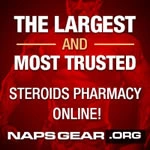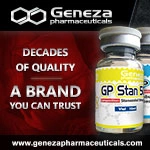GotTren
Hiatus

Dianabol History and Overview
Dianabol, known by its scientific and chemical name as Methandrostenolone is the most popular and widely utilized anabolic steroid by bodybuilders and athletes today. It gained its popularity in the late 1950s and throughout the 1970s. Methandrostenolone was introduced to the pharmaceutical and medical community by Dr. John Ziegler in the mid-1950s as an American response to the Soviet use of Testosterone in their Olympic athletes. Dr. Ziegler and his team created Methandrostenolone as a result, which was then introduced to the prescription market under the trade name of Dianabol by the Ciba pharmaceutical company. It was the first orally active anabolic steroid to be synthesized and sold on the prescription market.
Dianabol possesses a half-life of 4.5 – 6 hours, contains a moderate level of Estrogenic effects in the body, and has less of a rate of conversion into a stronger androgenic metabolite via the 5-alpha reductase enzyme. It is for these reasons that Dianabol tends to be favored by bodybuilders and athletes in the quest for mass and strength above all else.
Dianabol is methylated at carbon 17-alpha on its structure (this is simply the addition of a methyl group at the 17th carbon). This process, known as C17-Alpha Alkylation, allows the anabolic steroid to be administered orally and still have a measurably strong effect on the body. Without this modification, it is impossible for any anabolic steroid to survive liver metabolism in significant enough quantities to promote any measurable effects in the body – the result is that extremely miniscule amounts of the anabolic steroid reaches the bloodstream to perform its job. Dianabol also possesses a double-bond between carbons 1 and 2. This modification in particular is what grants it a ‘milder’ androgenic strength in comparison to its parent hormone Testosterone. This double-bond is what limits Dianabol’s affinity to bind to the androgen receptor in different tissues in comparison to Testosterone. It is these modifications that also allow Dianabol’s half-life to exceed that of Testosterone (Dianabol’s half-life is 4.5 – 6 hours). An additional benefit of these chemical modifications is Dianabol’s lower affinity for binding proteins to bind to it, such as Sex Hormone Binding Globulin (SHBG). These binding globulins (in this case SHBG), which are proteins, bind to sex hormones such as Testosterone, Estrogen, Dianabol, etc. and render them inactive temporarily. What results is essentially a bound hormone that floats around in the bloodstream and does nothing – it cannot bind to receptors or do anything – and is essentially useless. These are the chemical features of Dianabol that grant it its status of being a significantly potent anabolic steroid. One interesting point to note, however, is that Dianabol possesses a weaker interaction with the androgen receptor in comparison to Testosterone and many other anabolic steroids, yet it is a very strong and potent hormone in comparison. It is therefore speculated that much of Dianabol’s activity is that of non-receptor mediated activity. With this being said, Dianabol’s anabolic rating is known to be a rating of 210 in contrast with Testosterone’s anabolic rating of 100. What can be seen here is that Dianabol possesses slightly over double the anabolic strength of Testosterone, and this is because of the described structural modifications it possesses.
The Effects of Dianabol
Dianabol does succumb to some limitations of its own, with the first being its C17-Alpha Alkylated property. As previously mentioned, C17-Alpha Alkylation allows an anabolic steroid to become orally active and bioavailable – without it, the anabolic steroid would not survive liver metabolism. However, the negative downside in this case is that of increased hepatotoxicity (increased liver toxicity). C17-Alpha Alkylation allows an anabolic steroid to become more resistant to hepatic breakdown, and any compound that is further resistant to hepatic breakdown with always have greater hepatotoxicity associated with it. As a result, it is a smart choice to run Dianabol for periods no greater than 4-6 weeks at any given time in a cycle. This is to ensure healthy liver function, and for proper liver recovery following the cycle. It is because of the risk of hepatotoxicity that Dianabol’s main function in a cycle is to serve as a supportive kickstarting compound. Dianabol, nor any oral anabolic steroid, should ever be run solitarily on its own. Testosterone in some form no lower than a TRT (Testosterone Replacement Therapy) dose should always be run with an oral anabolic steroid such as Dianabol.
Dianabol contains moderate Estrogenic activity and is a compound that is exposed to aromatization by the aromatase enzyme, which is the enzyme responsible for converting androgens into Estrogen. This is why Dianabol is commonly known for its Estrogenic side effects of water retention, risk of gynecomastia, elevated blood pressure (often as a result of water retention), and possible fat retention/gain due to Estrogen. It has been mentioned already that Dianabol expresses far less androgenic strength and activity than does Testosterone, but it is important to understand that androgen-related side effects and issues are still a concern with Dianabol, although they are not as pronounced as Testosterone. Dianabol possesses an androgenic rating of 40-60, and when compared to Testosterone’s androgenic rating of 100, we can see there is quite a significant reduction – however, the risk of androgenic side effects can still be prominent especially in those individuals sensitive to androgenic side effects. Androgenic side effects can include: increased risk for male pattern baldness (MPB) if the individual possesses the genetic trait responsible for it, increased sebum secretion (oily skin) and associated acne, and increased facial hair and bodily hair growth. In addition, the 5-Alpha Reductase enzyme which is the enzyme responsible for converting Testosterone into the much stronger androgen Dihydrotestosterone (DHT) does also interact with Dianabol. In this case, Dihydrotestosterone is not created but instead Dianabol’s own more androgenic metabolite is the result. A positive note on this issue, however, is that Dianabol possesses a lower binding affinity for the 5-Alpha Reductase enzyme
Dianabol Side Effects
Dianabol’s side effect profile is variable. The most significant Dianabol side effect is that of Estrogen-related effects, although studies have stated that Dianabol’s action on the aromatase enzyme (CYP19) is moderate[6].
This includes water retention and bloating which will mean this oral steroid will increase blood pressure as well as acne and gynecomstia (development of breast tissue). The most prominent Dianabol side effect tends to be the bloating and water retention, followed by gynecomastia. These side effects can be mitigated through the use of anti-estrogens such as aromatase inhibitors Exmestane (Aromasin) and Arimidex, Estrogen blockers (SERMs) Nolvadex (Tamoxifen Citrate) and Clomid.
Secondary to the Estrogenic side effects, Dianabol can produce androgenic side effects as well (though less pronounced than Testosterone). There are risks of experiencing acne, oily skin, male pattern baldness, and benign prostatic hyperplasia.
The next most concerning Dianabol side effect is its increased stress imposed on the hepatic system. It is advised to limit cycle lengths to no greater than 4 – 6 weeks, supplement with liver support compounds, and avoid high dosages.
Lastly, Dbol is very well known for its strong inhibitive nature on the HPTA (Hypothalamic Pituitary Testicular Axis). Clinical studies have been conducted on Dianabol’s testosterone inhibitive action in humans, and they have demonstrated that doses as low as 15mg per day for 8 weeks caused total plasma Testosterone levels to decline by 69%.
Aside from these side effects, Dianabol does impose those side effects that are also typical with any anabolic steroid. These include negative cholesterol alterations, negative cardiovascular effects, and disruption of the HPTA (Hypothalamic Pituitary Testicular Axis).
Dianabol Cycles and Uses
Dianabol cycles are very straightforward in most cases of its application. The use of Dianabol is normally during periods of bulking and strength gaining where the bodybuilder or athlete is not overly concerned with water retention and bloating. These types of Dianabol cycles are therefore normally during the “off-season” period where bodybuilders are in the midst of achieving this goal, and it is normally cycled with some kind of injectable anabolic steroid that achieves similar results – normally some variant of Testosterone, such as Testosterone Enanthate.
Most of these Dianabol cycles involve its use as a kickstarting compound, where it is used only during the first 4 – 6 weeks of the cycle in order to experience strength and size gains while the user waits for the longer acting injectable compound (i.e. Testosterone Enanthate) to achieve its full effects and “kick in”. It is advised to run Dianabol cycles for no longer than 4 – 6 weeks due to its nature as a C-17 alpha alkylated compound, which exerts negative effects on the liver (and especially cholesterol levels). This is an additional reason as to why Dianabol cycles are typically kickstarter cycles for no greater than 4 – 6 weeks in length.
Shorter Dianabol cycles can be run, but in this case it should be run with a short-estered base injectable. Referencing back to Testosterone in this case, the preferred choice would be Testosterone Propionate. However, Dianabol cycles in these instances should still be limited to 4 – 6 weeks (while the Testosterone Propionate, for example, can be extended well beyond this length if desired).
Dianabol is very rarely employed as a cutting or fat loss agent, although it can be done. It is generally undesirable to do so because of Dianabol’s negative Estrogenic effects (such as water retention and bloating). Because of this, the physique’s definition during dieting can be difficult to gauge as the water retention blurs this. Dianabol cycles intended for cutting or fat loss should be run no differently than previously outlined cycles, as fat loss is first and foremost achieved through the athlete’s diet and nutritional intake and not determined by which anabolic steroid is utilized.
Dianabol Dosages and Administration
Being that Dianabol is considered a very potent anabolic steroid where anabolism (the buildup of muscle tissue) is concerned, its dosages need not be as high as many other commonly used oral anabolic steroids. Dianabol dosages need to be considered carefully especially where negative effects on the liver are concerned, as the higher dosage is used, there is a corresponding increase in the negative effects here.
Dr. Ziegler originally issued prescription guidelines of 5mg per day for no longer than 6 weeks. Being that 5mg is on the lowest end of the dosage spectrum, more modern beginner Dianabol dosages range between 15 – 30mg per day. This Dianabol dosage, especially the higher end, is quite considerably strong in terms of anabolic effects and does not necessitate an increase beyond it even after years of cycles. Intermediate as well as advanced dosages for Dianabol are in the area of 30 – 50mg per day, and it is generally advised to go no higher than this despite the fact that some very advanced users are known to venture well into the 80mg or greater range. It is very unadvisable to even attempt to approach this range due to excess stressors on the body’s organ systems and side effects.
It should also be mentioned that the difference between beginner, intermediate, and advanced users is not that of increasing Dianabol dosages, and that many advanced users tend to utilize a low beginner dosage of 15mg per day with a high degree of effect.
That said, some studies have looked at the adverse side effects of 100mg per day and were found to have shown no serious complications in health[5].
Looking at this study in more detail, 100mg per day for 6 weeks meant total testosterone declined 40%, LH dropped to 80% of its original baseline value, FSH decreased 33%, human growth hormone (hGH) rose 30% and Fat Free Mass also increased from 2-7kgs.
Female Dianabol dosages are relatively unheard of due to the fact that Dianabol is not a commonly used anabolic steroid by female athletes due to its unsuitability as a result of harsher virilization effects on the female physiology. Those females that do venture into Dianabol use have been known to utilize 2.5 – 5mg per day, and 10mg daily being the uppermost limit. These dosages can produce very dramatic results for the few female users that exist.

Dianabol Methandrostenolone (AKA Dianabol)
Chemical Name: 17a-methyl-17b-hydroxy-1,4-androstadien-3-one
Molecular Weight: 300.441 g/mol
Formula: C20H28O2
Original Manufacturer: Ciba (originally)
Half Life: 4.5 – 6 hours
Detection Time: 5 – 6 weeks
Anabolic Rating: 90 – 210
Androgenic Rating: 40 – 60
If you knew better you'd do better! Knowledge is power!!












